This web page contains the logs of the second leg from a thirty seven day sailing trip that I took with S/Y Thetis around the Greek Aegean. The leg lasted for ten days and it was from the island of Santorini to the island of Kea both in the Cyclades. Islands visited on the way are: Folegandros, Sifnos, Syros, and Kithnos. Thetis started the leg in the company of S/Y New Life belonging to my friends from Turkey Turgut and Arzu Ayker. Their son Orhan sailed with Thetis from Santorini to Folegandros while their daughter Dilek crewed on Thetis from Folegandros to Sifnos. From Sifnos New Life went on to the coast of Peloponnesos while I singlehandled Thetis to Syros where New Life joined me a few days later. For the rest of the trip I sailed solo.
The logs are illustrated with maps and photographs, and also include some historical and geographical descriptions of the places visited as well as several links to other related web sites.
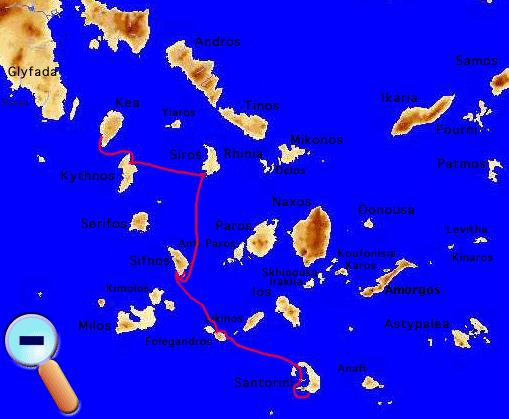
Friday September 1, 2000, Day 11
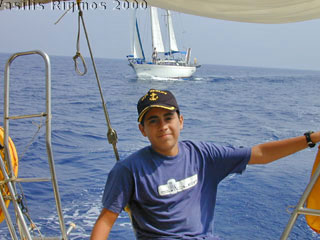
I got up at 6:30 AM to prepare for the sail to Folegandros. Before our departure, while the rest of New Life’s crew was getting ready, Turgut and I took a walk up the cliffs and photographed the Santorini Marina. Both of the Ayker children wanted to crew on Thetis, but not together. Finally they settled on Orhan on this passage.
We had a slight glitch with a fouled anchor but we quickly took care of the problem and by 0845 we were on our way New Life followed behind us. There was absolutely no wind and the sea was flat. We motored W along the south coast of Santorini past Cape Akrotiri after which we turned N into the caldera going W of the Palea and Nea Kameni islands towards Pano Meria or Oia. At Oia we slowed down and took some pictures, we then exited the caldera and headed for Folegandros.
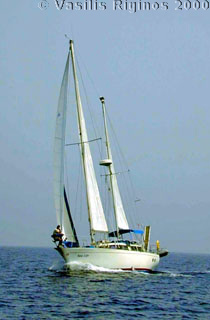
New Life |
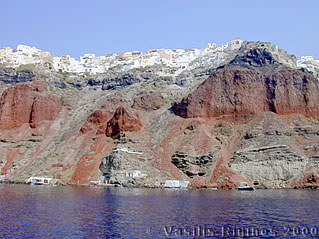
Pano Meria |
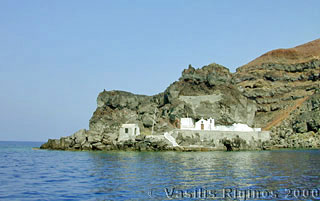
By this time the wind had risen to a very modest 7-8 knots SW. We put up the tent and opened the headsail, mostly for fun. While motor-sailing, New Life overtook us as we were photographing her. On the way, Orhan entertained me by playing his nice collection of Turkish CDs. He also helped me tape the foot of the genoa that had become un-stitched.
We arrived in Karavostasi (Καραβοστάσι) [36° 36.9' N 024° 57' E] the main harbor of Folegandros at 1435. The distance we traveled was 33.5 M. No sooner had we entered the harbor than the wind, in its perversity, increased to 16-20 knots. This made the maneuver of docking stern-to kind of difficult in the cross-wind. To make matters worse, Orhan, being unfamiliar with the windlass, had some trouble controlling it. Nevertheless, we docked without any mishap. Orhan is an excellent sailor and a very pleasant sailing companion.
Folegandros (Φολέγανδρος) is a small barren rocky island E of Milos and S of Serifos. It used to be one of the most isolated islands in Greece where political exiles were sent, as recently as during the Junta of the Colonels (1967-72). Also, its town Chora has some of the best examples of Cycladic architecture. Unfortunately, the island has been “discovered” and its 600 inhabitants multiply many times over every summer with tourists, complete with bars, discos, etc. Still it does have wonderfull architecture and one can take many nice walks in its stark terrain.
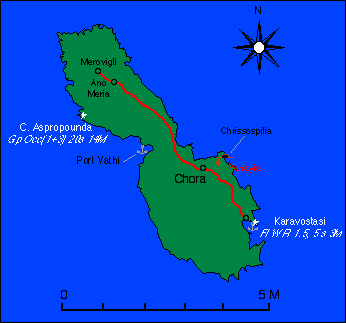
Folegandros gets its name either from the son of King Minos of Crete or from the Phoenician word Phelekguduri meaning rock-built.
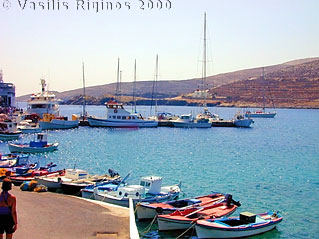
Later the SW (Garbis - Γαρμπής) wind kept increasing and by the late afternoon it was gusting to 35 knots. The Karavostasi harbor is exposed to this wind and the boats were blown towards the quay. We put spring lines and deployed a second anchor so that Thetis and New Life were held by three anchors. We also had to abandon our plans of visiting Chora because we were not too comfortable with leaving the boats unattended.
In the evening a small chartered sailboat arrived and had a most terrible time docking. The young British couple could not control it. They came very close to damaging Thetis had not Seref, New Life’s crewman, Turgut, a Dutch sailor from a nearby yacht, and I rushed and fended it off while a local fisherman held a line with all his might. It turns out that they had engine trouble and their engine could not develop enough power to allow them to effectively maneuver. Eventually the fisherman and the crew of a mega yacht that had just arrived came to the rescue and towed them to a safe place and they anchored offshore.
At least 3 other yachts arrived and anchored off. One of these anchored exactly on the path of the expected ferry. The poor Limenarchis (Harbor Master) was pulling his hair. He waived and gesticulated to no avail. We all came to his assistance yelling in several languages but the wind was too strong for them to hear us. I was getting ready to ferry the Limenarchis, in his white uniform with the dinghy to the yacht but it would had been a very wet ride. Fortunately, the owner of a much larger inflatable volunteered for the task. When the Limenarchis came back he returned the storm jacket that I had loaned him and thanked me. He could not resist commenting: “I really do not understand you yachties. Obviously you are all rich and can afford your expensive yachts. Yet, how do you chose to spend your vacation? Doing hard, miserable, wet work. For me, if I could afford it, I would be staying in a luxury hotel and be served.” Sometimes, I too, have a hard time understanding us yachties…
Arzu prepared dinner aboard New Life. She served us a delicious pasta with sauce made of tomatoes and tuna. Raki, ouzo, and wine were consumed liberally in the cozy cabin while the wind outside howled. It did not stop howling all night.
Saturday September 2, 2000, Day 12
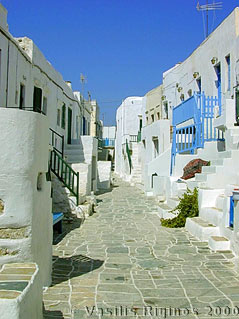
In the early morning the wind died out. After doing some housekeeping chores, the Aykers and I took the bus to Chora. The last time I was on the island was back in 1970. It was then one of the most enchanting of the Cyclades. Gone now is the lovely cobblestone foot path that used to lead from Karavostasi to Chora. Now, busses, cement trucks, and nosy motorbikes rule over the ugly asphalt road. In Chora there are now many new houses, made of concrete, and up-scale stores catering to the tourists. Fortunately many of the old houses, especially within the Kastro (walled-in) area still remain and are well maintained retaining their colorful bougainvilleas. We wandered around, taking pictures. We located the bakery and bought some very good hot bread. After a while we ended up at a café in the shaded square, the platia. And while all 3 cafés have morphed from old fashioned kafenia to up-scale modern cafés with espresso machines, drinking coffee in the platia is still a pleasure. All together, I have to admit, Folegandros has not deteriorated as badly as I was afraid.
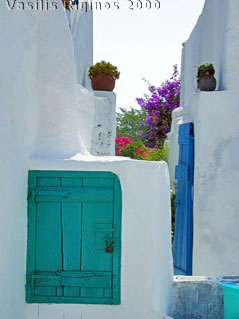
A House |
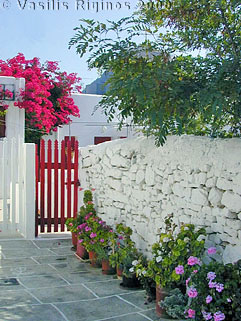
A Street |
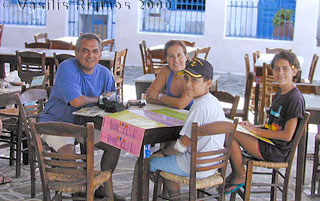
Turgut, Arzu, Orhan, and Dilek Ayker |
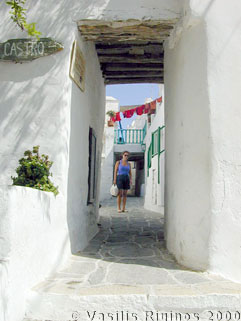
In the Kastro |
After our rest at the platia we took the bus down to Karavostasi. By this time there was no wind and it was hot! We all took a refreshing swim right off our boats in the clean waters of the harbor. Our plan was to sail to southern Sifnos. Now it was Dilek’s turn to crew with me in Thetis. While up on Chora we had spotted a very attractive looking cove, so we decided to have a stop there for another swim.
By 1350 we were on our way. New Life leading and slower Thetis motoring behind. The cove was just 3 M NW from Karavostasi. We stopped [36° 38.1' N 24° 54.8' E] at 1430 but it was too deep for anchoring, at any rate, we only wanted to have a quick swim. So we let the boats drift.
Turgut launched his dinghy (New Life has davits), and he and Arzu went ashore to the inlet of the cove while Orhan stayed aboard New Life. After a while Turgut came back and offered to baby sit Thetis and let Dilek and me join Arzu ashore. As we were pulling away in New Life’s inflatable, Turgut suggested that we take a mask because the bottom of the cove was exceptionally clear and beautiful. I, without thinking, asked Turgut to open the starboard sail locker and get me a mask. What I failed to realize was that the autopilot’s tiller-actuator was still engaged and attached to the lid of the sail locker. Before realizing my mistake, I watched, in horror, as Turgut opened the locker and the autopilot actuator dropped overboard into the deep blue. Visions of long phone calls to Athens, and days wasted at post offices or various courier offices waiting for the arrival of an expensive replacement, quickly flashed through my mind. Poor Turgut! He was devastated, as if it was his fault. Greatly motivated by my visions, I quickly put on the mask and flippers and jumped into the water. The bottom was mostly dark weed with small patches of sand. It was about 15 m deep. I did not have to search for long. There on a sandy patch was the actuator, looking tiny as if it was a toy. I had not dived that deeply for many years. I hyperventilated and taking a very deep breath, dove towards the actuator. Adrenaline drove me, I reached it and retrieved it. Back on Thetis I immediately rinsed it with fresh water, opened it, drained it, rinsed it again, and then I let it to dry by the sun. After that, Dilek drove the dinghy ashore where Arzu was waiting wondering by now what had happened to us. The cove and its water were indeed lovely but I was not in a mood to appreciate them. Also, my ears ached. By the time we returned onboard Thetis, the actuator was already dry. I plugged it in and to everyone’s relief and delight it worked! I disconnected it and let it dry in the sun some more.
It was 1525 by the time we were on our way again on a heading of 325°. The wind was a light 5-9 knots SW. Dilek helped me put up the tent and open the headsail. We motor-sailed. After about an hour, I connected the autopilot. It worked! My relief knew no bounds. I immediately hailed New Life on the VHF and told Turgut the good news. During the passage, Dilek, unlike her brother who was full of activity and wanted to know everything, was very quiet. She just read her book in the shade of the tent. Yet, she was immediately there whenever any need arose. She too, is an excellent sailor and a good companion.
We arrived in the Vathy [36°55.7'N, 24° 41.2'E] cove in the SW of Sifnos at 1850. Out distance from Folegandros was 27.8 M. We anchored off without any trouble. The batteries were completely charged and the watermaker had refilled the water tanks. Too bad we had not sailed.
Sifnos (Σίφνος) is a windy and hilly island with an area of 74 km² and about 2000 inhabitants. Its highest peak, Profitis Ilias, is 678 m (2225 ft.) above sea level. Its west coast is barren but the east coast is greener and cultivated. The island is well known for its Cycladic architecture, its pottery, and its chefs. Several wealthy shipowner families come from Sifnos and maintain beautiful houses here.
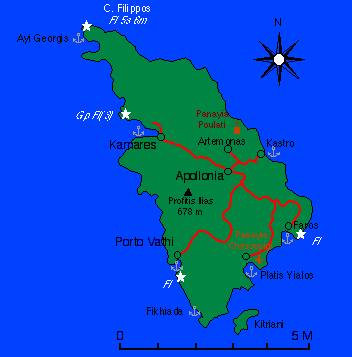
In antiquity, Sifnos, known as Meropia, was famous for its wealth from its gold and silver mines. This mines go back to the 3rd millennium BC and are the oldest mines discovered in Europe. The earliest inhabitants appear to have been Phoenicians who were replaced by Minoans who founded Minoa near the modern town of Apollonia, the island’s capital. The Minoans were replaced by Ionian Greeks who lived near Ayios Andreas. The Meropians were not only very wealthy but were also greedy. They were discovered to have cheated the oracle of Delphi by contributing instead of pure gold, lead eggs just gilded with gold. This discovery gave a good excuse for Polycrates of Samos, on behalf of Apollo, to invade and plunder the island. After this the island declined.
In the middle ages most of the population lived near Kastro and were dominated by the Venetians who were succeeded by the Ottomans in 1617 AD. In the 17th century the Ottomans attempted to reopen the mines but were thwarted by French pirates supposedly hired by the islanders. After the Greek War of Independence, Sifnos joined Greece and a French interest reopened the mines and operated them until 1925.
We spent the rest of the afternoon swimming and relaxing. Later, after showers etc., we all went ashore and had a wonderful dinner at the reliable Tzikali restaurant. It was a farewell dinner because tomorrow we were parting company. New Life will be sailing for Spetses and NNE Peloponnesos while Thetis will be heading to Syros. If time allows New Life may also stop in Syros.
Sunday September 3, 2000, Day 13
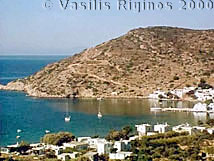
I spent a very laid back and lazy day. After the excitement of the past few days I did not even feel like going ashore. I just sat under the tent reading and occasionally taking a plunge in the water.
I received a SMS message from New Life. They had arrived in Spetses and, following my suggestion, were anchored at Zygouria. I also spoke on the GSM phone to my wife Alice in Washington. My bother Nikos called. He is with the Faneromeni in Kea with our younger brother Byron and in a few days he will head to Porto Heli.
In the evening I made for supper a rice pilaf with tuna and capers.
Monday September 4, 2000, Day 14
Tired of being lazy, and well rested, I got up early and went ashore. I walked for over one hour up the hill until a bus came along and I flagged it. It took me to Apollonia (Απολλωνία), the capital of Sifnos. I wanted to visit the Museum of Popular Arts and Folklore but it had not yet opened. I bought some fresh bread and had an orange juice while waiting for 10 AM, the Museum’s opening time. The exhibit was all right, but nothing special: some old photographs, some books, embroideries, costumes, and cooking artifacts from the 19th century. The most interesting was an exhibit of special Easter breads, all in very fanciful shapes. After the Museum visit, I took the bus back to Vathy and Thetis.
While I was having a tomato salad for lunch the SW wind strengthened causing an uncomfortable swell. As I wanted to visit Platys Yialos, where many of the potters have their shops, on the E side of the island, I decided that now was a good time to go.
I raised the anchor at 1345. First, I motor-sailed S to the nearby Fikiada cove, to check it out. It looked very attractive. One house and one tent. I then continued to Platys Yialos taking the channel between Sifnos and the Kitriani Island. There was no problem getting through the channel as its depths are better than 20 m.
Thetis arrived in Platys Yialos [36° 55.7' N, 024° 44' E] at 1505, 5.6 M. Here also, was a considerable swell. I anchored in 5 m on sand. The anchor held very well but it was not comfortable. Nevertheless, I made myself a cup coffee and then took the zodiac ashore. I checked several pottery shops and finally bought some cooking pots. These cooking ware were once the main product from Sifnos and were famous all over Greece. Now the selection was rather meager. The emphasis has sifted to the decorative ware that the tourists are perceived to favor. It is rather a shame!
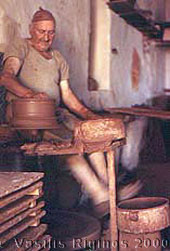
After getting the booty back on board, I decided to leave and go back to Fikiada [36° 54.4' N 024° 42.25' E] that looked so inviting and calm. We left Platys Yialos at 1740 and motored for 3 M south to Fikiada where we arrived at 1820. I anchored in 6 m. The anchor caught and buried itself in the sand.
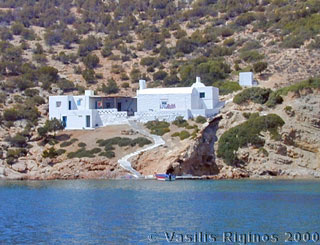
I made myself a pasta with mushrooms and hot pili-pili peppers. The night was a very pleasant one with the half-moon illuminating the calm sea. The only discord was the single light from the one and only house that blanketed some of the stars. Life is not always perfect.
Tuesday September 5, 2000, Day 15
During the night, the swell increased annoyingly as the wind shifted more from the W. I was woken up and it just got worse to the point that I felt that there was no way I could get back to sleep and I may as well go on to Syros, and on the way, have some nice sailing. I raised the zodiac and pulled up the anchor at 0245. Outside the Fikiada cove the wind was a light 9 knots W. We motored around Kitriani Island. After clearing the island, the wind increased slightly, so I raised the main but being night, I left it on its 2nd reef. I also opened the genoa. Thus we motor-sailed for about 10 M when the wind increased further to 15-25 knots coming now from the WNW. This change made sailing possible so I turned off the motor and managed to sail the rest of the way. The only problem was that the white stern navigation light burned. I used a spare, battery-operated.
By 0920, after 34 M we were in Finikas, in the SW of Syros [37° 23.8' N 024° 52.7' E]. The dock was very crowded but I never liked it very much, so I anchored off, at my usual spot in 6.5 m despite the presence of some swell.
I felt tired and very lazy. I put up the tent and snorkeled to check the anchor. I then looked at the stern navigation light. Its leeds were corroded and will need replacement. Other than that, I just sat under the tent reading. After lunch, I fell asleep.
Later, when I woke up somewhat refreshed, I washed the boat and called my friend Yiankos Krinos in Piskopio. Their son, Manolis, had just arrived from the US and they also had a house guest. We made arrangements to get together tomorrow. Turgut also sent me a message. They were on their way, due to arrive at Finikas tonight. I did not expect them any sooner than Thursday.
I spent the rest of the day quietly aboard. In the evening, I went ashore. At the small chandlery store I bought a new valve for the zodiac, maybe it will do the trick and stop its slow deflation. I also checked the quay area that has now become a marina with some electricity and water outlets. Tonight though, it was crowded and exposed to some bad swell. I found the telephone of a diesel mechanic, Mr. Rousos. I called him and he will come tomorrow between 10:30 and 11 to look at my leaking cooling-water pump.
As I was driving the zodiac back to Thetis, New Life was entering. I advised them to anchor off and avoid a night docking maneuver and the bad swell near the quay. They did so without any trouble near Thetis. Later we all went ashore and had a nice dinner at the old reliable Dionyssos.
All night we were exposed to a light W wind and a strong swell.
Wednesday September 6, 2000, Day 16
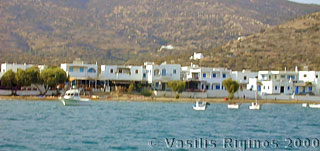
In the early morning hours the wind blissfully changed from SW to NNW and the swell subsided somewhat.
While waiting for the diesel engine mechanic, I siphoned fuel from the two spare jerry cans into the tank. I then took the cans ashore and wheeled them with my cart to the gas station and re-filled them with 46 L of fuel. I also took some of my dirty clothes and left them at the chandlery as they provide a laundry service.
In the mean time, New Life had moved and docked stern-to in the marina. They had connected to the AC electricity and started charging their batteries and re-filled their water tanks. It turned out that they too had some water-cooling related problems and needed the services of the expected mechanic.
So that we would not waste too much time, I removed my defective water pump, took it to the marina with the dinghy and waited in New Life for the mechanic. He eventually came, not too late for a Greek mechanic, and repaired the problem in New Life. He took my pump and promised to have it ready, in his shop in Talanta, by 3 PM.
Turgut and I walked to the chandlery where I had earlier made arrangements for a car rental. The car was ready and we all boarded it for another land based expedition. First we drove to Galyssas and had a swim.
By the time we finished swimming, it was near 3 PM and we drove to Talanta looking for Mr. Rousos’ shop. We had a very hard time locating it. Asking for Rousos was no help at all. It turned out that at least half of the Syros population is surnamed Rousos. It took several uses of the GSM phone before we located the shop. We were rewarded by the pump being ready. He had changed the impeller, which had a broken blade, and the bushing. Total bill less than 15,000 GRD. Not bad!
Taking advantage of the car, we then drove to the Ano Meria, the wild north side of the island. It was a very pleasant ride, with frequent stops for photographs and walks.
When we returned to Finikas, I went aboard Thetis and installed the pump. I started the motor. No leak, not even a drop! I was delighted. In the mean time, Yiankos had called. We made arrangements to drive to his place at Piskopio and have a drink. This would allow the Aykers to see a restored old neo-classical mansion.
So, after showers we drove to Piskopio and I introduced my Turkish friends to my Greek friend and his American wife. Sue and Yangos were as usual most gracious hosts. I also met finally Yiankos’ son, Manolis, about whom I had heard for years from his proud father. After the drinks, as it was already dark and time for dinner, we all drove to Ano Syros where we had a most agreeable dinner at Lilys. Lilys is the oldest restaurant in Syros and I must say, one of the best in the Cyclades. It was a wonderful evening. Before parting, the Aykers invited the Krinos for breakfast in New Life.
When we returned to Finikas we were further pleased to notice that the swell was way down. This had been a long but satisfying day.
Thursday September 7, 2000, Day 17
I got up earlier of course, well before the 8:30 that we were invited for breakfast aboard New Life, but I got carried away with some housekeeping tasks on Thetis. As I was driving the zodiac to the marina, Turgut called me to remind me of our appointment. It was only 8:40! When I got to New Life I found everyone, including the Krinos, already there. There were sitting around the cockpit table which was set, complete with a colorful tablecloth. Arzu had prepared quite an impressive spread. There were several breads, already sliced, croissants, cheeses, jams, cold cuts, coffee, and tea. It was almost 11 by the time we finished “breakfast” and said our good-byes.
After the Krinos family left, the rest of us got into the rented car and drove to Ermoupolis, the capital of Syros. We walked around. I bought two jars of capers (Syros has some of the best capers in Greece), some loukoumia (Turkish delight, another specialty of the island), and some chicken to be cooked for dinner. Arzu looked into several antique stores to get ideas for their new house that they are building in Izmir. We also found a very nice store specializing in coffees where we all bought large supplies. During our walk in the town we kept bumping into Yiankos and Sue and kept repeating our good-byes.
On our way back to Finikas, we stopped at the Platia Iroon (Heroes Square) for Turgut to buy some items from the Orologas chandlery. The new proprietor, Lefteris Mboyiatzoglou, recognized me immediately and we renewed our friendship. Turgut found what he was looking for and in the mean time my eyes fell on an interesting looking hand pump. Lefteris explained that it was an American-made pump for siphoning fuel and other liquids. As it was not too expensive and my old siphoning pump leaked I bought it. It turned out to be a great tool.
When we got back to Finikas we returned the car and I picked up my clean laundry. New Life began preparations for departure. They were planing to go E to Rhinia and from there tomorrow, depending on the weather to either Chios or Arki because Turgut must be in his office on Monday. So we all said good-bye and wished each other fair winds.
After New Life cast off I went back to Thetis and put up the tent and then had some lunch. I took stock of the situation. The engine water pump is fixed. The zodiac is still leaking despite the valve replacement. The bilge pump is OK but I will need to replace its return valve. The only item that I could do something about was the stern navigation light. This took me some time, because the leeds to its fixture were heavily corroded. This was not the only problem. The positive leed did not make good contact at the panel either. I repaired the connections, soldering new leeds. I also made a change at the central panel. I solder the cables from the red, green, and white navigation lights as well as the wires from the compass light to a common cable which I then connected to the panel. Now everything is working again.
In the evening I cooked the chicken that I had purchased in Ermoupolis with fresh tomatoes and potatoes from Kalami. While cooking I ran out of Camping Gaz and I had to replace the canister with the spare. The food was very good but even better, there was now another meal already cooked in the refrigerator since I cooked more than I could eat. The wind had definitely subsided despite the earlier Navtex forecast calling for “strong winds.” If this weather holds I will leave tomorrow for Kithnos and Kea.
Friday September 8, 2000, Day 18
I got up, without the alarm, around 7 and started getting ready to leave. I then took the dinghy ashore to buy fresh bread, spring water, fruits, and, most importantly, a replacement Camping Gaz canister. The small grocery store that is so conveniently located across the landing dock and that had been serving yachts for the past 15 years is going out of business due to increased rents. They will be closing down tomorrow. Too bad! I walked the 100 m to the “supermarket” up the road and got the canister. The bread I got, of course, from the new bakery that opened 2 years ago. They make excellent bread.
By 0910 all the provisions were stowed and the anchor was up. The sea was calm and the wind still had not materialized. So, I towed the dinghy rather than raise it. When we were outside of Finikas. I raised the main, shook the reefs and motor-sailed to Kithnos. I wanted to check its eastern anchorages. Not a drop of water spilled out from the engine water pump. The wind was 5-9 knots N. The barometer had risen to 1012 mB from yesterday’s 1008. Since the ride was very calm I did a number of boat keeping tasks: I oiled the teak railings, cleaned the stainless steel posts, etc.
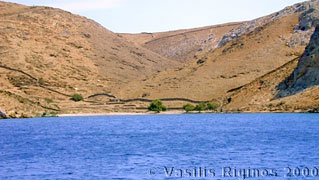
As we were nearing Kithnos. I saw, not far from Thetis, an enormous fin sticking out of the calm water. I changed course so that I could go closer and look at it, it dove but before I could photograph. It must have been a large shark.
We arrived in the inlet of Ayios Ioannis & Ayios Stefanos [37° 23.3' N 24° 27.9' E] in NE Kithnos at 1220 after 18.8 M from Finikas. I lowered the sail. It is an attractive area with several possible pleasant anchorages. I took a number of pictures but did not stay. While underway, I warmed some leftover pasta and ate it as we were leaving the inlet. I wanted to also check the Loutra area, further N but the wind and waves were getting stronger and mindful of the forecasted “strong winds” I gave up on the idea and pushed on to Kea. I raised the main again and opened the headsail. Our course, however, we were too close to the wind and once again I had to motor-sail.
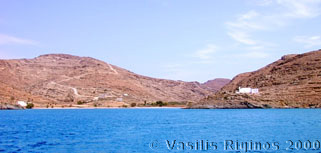
While still near Kithnos, I saw a big flock of large black birds flying low in formation towards the island. I do know what they were but I have never seen them before.
After reaching Cape Kefalos, the NE point of Kithnos, we changed course and were at last able to sail and shut down the motor. The wind by now had increased to 10-17 NE which allowed us to sail all the way to Koundouros [37° 34.7' N 24° 16.6' E] in Kea which we reached at 1620. Our mileage from Finikas was 40.1 M. I had already communicated with my brother Byron who had advised me that all the permanent moorings were in use. I anchored in 4 m and took a 60 m line to a rock on the NW shore.
I took a swim and checked the anchor. After that, I had a well deserved hot shower and relaxed reading in the cockpit while waiting for my brother and his wife Ivi to arrive from Athens. They came sometime past 8 PM with a car full of youths, most of them recent graduates from Athens College (my alma mater also). They were all friends and classmates of Dimitris, Ivi’s son, who was celebrating tonight his 20th birthday.
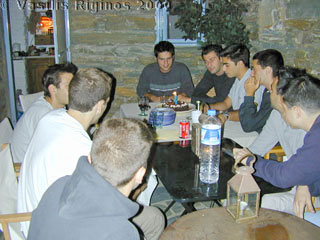
I rode with them up to their house. Ivi had brought a nice meal, complete with cake, for the birthday celebration. Altogether there were 10 husky youths who filled the verandah. It was past midnight when I left riding Byron’s motor-scooter. The ride down the dark, steep, dirt road was more scary to me then any gale.
Still no wind. The cove was calm and peaceful. The new Navtex forecast called for “very strong northerly winds for all Hellenic seas.”
Saturday September 9, 2000, Day 19
I spent the early morning listening to music and reading Toni Morrison’s Beloved. Later I did various boat-related tasks: I cleaned the main cabin (soap the wood surfaces), oiled the teak in the cockpit, inflated the zodiac (this has become a daily chore). I followed Byron’s suggestion and greased the zodiac’s valves. Maybe that will reduce the air leak.
Because of the dire forecast I set the second anchor. I did this although my primary anchor was over sand, the bottom here is mostly slate with a thin sand layer, so dragging was a possibility. With two anchors this was minimized.
Around 11:30 Byron called. They are slowly getting up. I had a light snack and then I packed my Macintosh iBook computer and rode the scooter up to Byron’s house at Katevati. Byron and Ivi were up but the boys were still asleep. I connected the computer to the telephone. This allowed me to check my bank and credit card accounts and pay the outstanding bills.
After the young men got up and had a large breakfast, Byron, the 10 youths, and I drove down to Koundouros and boarded Byron’s large and fast inflatable, the Moruda, and went S to a nearby small cove for swimming. The wind was fairly strong and there was a considerable amount of chop. On the way back, we stopped at the Kambi cove for a late lunch (it was past 5 PM). The ride back to Koundouros was very wet.
After I got back to Thetis I read my e-mail with the Nokia Communicator and continued reading the Morrison book.
It was past 9:30 when I rode the scooter back to Katevati where I had dinner with Byron and Ivi and their friends and neighbors Nikos and Elenitsa Rota.
It was well past midnight when I returned to Thetis. I had some difficulty raising the dinghy’s anchor. It was stuck and I was forced to leave it in the water after I tied a fender to its line to act as a buoy. The Navtex had received the latest forecast: gale in SW Aegean and force 7 near gale north winds here at the Kafireas strait. The wind here was howling around 25 knots but the barometer had risen to 1019 mB. I guess that I will not be leaving Kea any time soon.
Sunday September 10, 2000, Day 20
This was a fairly quiet day despite the 15-25 knots wind. I took my mask and snorkel and retrieved the dinghy’s anchor that I had abandoned last night. In the late morning I rode the motor scooter up the hill to Byron’s and hung out with Ivi and Byron.
In the late afternoon Byron and I took his inflatable and went for a swim. I then helped him take the boat out of the water and drive it to his house in Katevati. I then returned to Thetis for a hot shower. My friend Manos Castrinakis called while I was gone and left a voice mail message. He wants to join me for a few days. I called him back but he was not in, I too left him a voice mail message.
Later Byron and Ivi came and we three went up the hill from Koundouros to the St. George restaurant where we had a fairly nice dinner. After dinner we all went aboard Thetis and watched the moon while sipping sweet Samos Moschato wine. We then said our good-byes because they will be taking an early morning ferry to get back to Athens.
In the mean time, the wind here is appreciably down and the latest Navtex forecast called for force 5-6 in the Kafireas strait with gradual diminishing of its force. If it seems OK, I too will leave tomorrow morning for either Batsi, Andros or for Vourkari in the NW of Kea.
The total distance for this leg was 144 M in 25.7 sailing hours out of which 15.7 were solo.